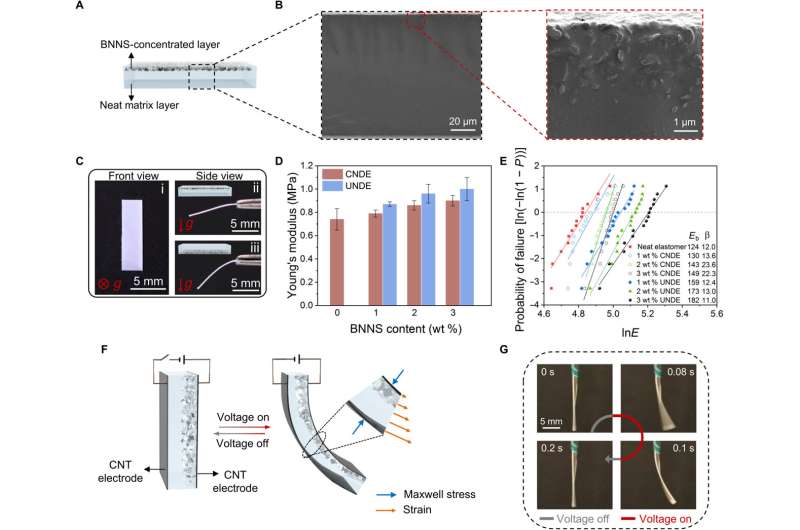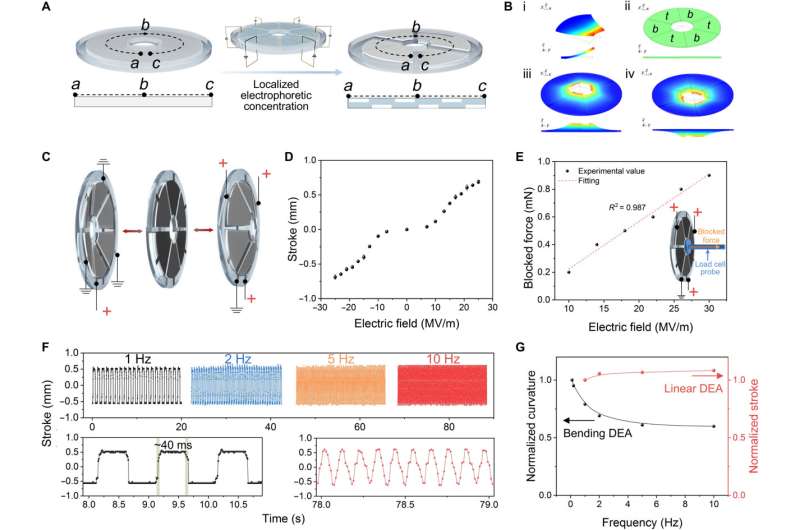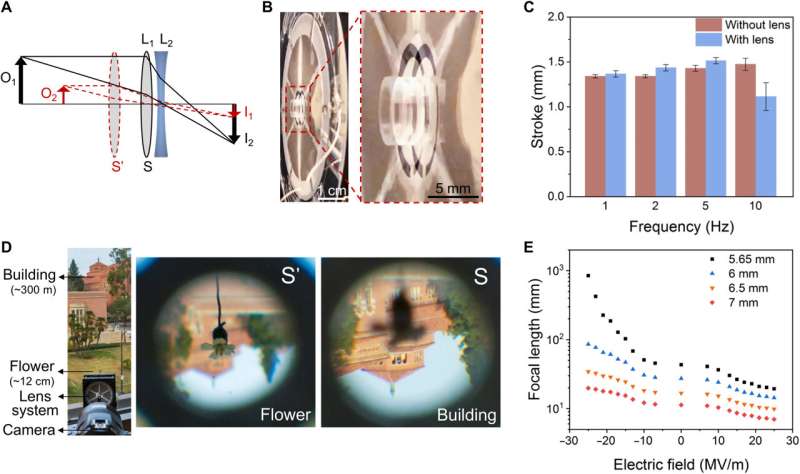Illustration of electrophoretic concentration process to create an UNDE film. (A) BNNS dispersed in a dielectric elastomer monomer solution are attracted to the positive electrode surface through an electrophoretic concentration process. (B) A setup to study the kinetics of the electrophoretic concentration process: A light source and a photodetector are placed on opposite sides of a cuvette chamber where the electrophoretic concentration of BNNS takes place. (C) Grayscale images of the cuvette chamber taken by the photodetector at specified elapsed time of the electrophoretic process. The electric field applied is 4 MV/m constant. (D) Recorded grayscale value versus electrophoretic time at the specified electric field. The grayscale value is taken as the average value along the dashed line shown in (C). Numbered arrows indicate the time the images in (C). Credit: Science Advances (2022). DOI: 10.1126/sciadv.abm6200
Dielectric elastomer actuators (DEAs) can undergo large, reversible in-plane deformation. In a new report now published in Science Advances, Junhong Pu and a team of scientists in soft materials research and polymer science at the University of California, Los Angeles, U.S., and Sichuan University, China, introduced an electrophoretic process to concentrate boron nitride nanosheet dispersion in a dielectric elastomer precursor solution onto a selected electrode surface. The team obtained a unimorph nanocomposite dielectric elastomer abbreviated UNDE with a seamless bilayer structure containing 13 times the modulus difference. The team could actuate the UNDE construct to large bending curvatures with enhanced durability compared to conventional nanocomposite dielectric elastomers. They arranged multiple UNDE units in a simple electrophoretic concentration process using patterned electrode areas; then, by using the actuator, they developed a high-speed lens motor with variable focal length to form a two-lens optical system.
Unimorph nanocomposite dielectric elastomers (UNDE)
Dielectric elastomers are a class of electroactive polymers that can transduce electromechanical energy via an electrostatic stress mechanism, in response to an applied voltage. The materials are characterized by their large strain and high energy density and have attracted tremendous interest in the past decade for applications as artificial muscles and soft robotics. Acrylic elastomers are of interest due to the largest actuation strain that they exhibit, and the pre-stretch procedure involved during fabrication. Materials scientists aim to avoid the pre-stretch process with acrylic elastomers by introducing a second interpenetrating polymer network and chemical modification to achieve large actuation strains without pre-stretch. In this work, Pu et al. introduced an electrophoretic approach followed by in situ crosslinking to fabricate an interface-free unimorph nanocomposite dielectric elastomer made of locally concentrated boron nitride nanosheets (BNNS). The team used the electrophoretic process to produce multiple functional unimorph units in a disk-shaped monolithic DEA film through customized electrode patterning. They varied the actuation strain with applied voltage without materials degradation and the compact actuator produced large linear actuation for use as a direct-drive lens motor, for optical zoom systems.
Achieving a bending curvature of 4.4 cm−1 at a field intensity of 28 MV/m, resulting in an almost closed-loop structure. Science Advances, 10.1126/sciadv.abm6200
Developing and characterizing a unimorph nanocomposite dielectric elastomer (UNDE) film via electrophoretic concentration
Pu et al. developed the UNDE (Unimorph nanocomposite dielectric elastomer) films with highly concentrated BNNS (boron nitride nanosheets) on one surface via electrophoresis. The boron nitride nanosheets are commonly used as a dielectric filler to enhance dielectric strength and can be dispersed in a dielectric elastomer to form a colloidal suspension. The team injected the dispersion between two parallel electrodes with a direct current field applied between them. Since the BNNS was negatively charged, the materials were attracted to the surface of the positive electrode. The team cured the precursor via ultraviolet exposure and formed a continuous bilayer structure. They imaged the process using a light beam passed through the cuvette chamber during electrophoresis. After developing the UNDE structure, Pu et al. used scanning electron microscopy images to observe the characteristics of conventional nanocomposite dielectric elastomers as a control material, and the UNDE with 3 percent BNNS in its composition. The team noted smaller bending curvatures for the UNDE film with BNNS concentrated on the top layer, compared to the bottom layer. The work indicated higher stiffness for BNNS-concentrated layers when compared to those with depleted concentrations. The scientists explored the optimized materials to obtain binding actuation by applying a high voltage across the UNDE film. After applying an electric field, the two layers of the construct experienced uniform compressive strains under cycles of bending and recovery.
Reframing the up-side-down scene from the flower to the building, to achieve a 230% focal length increase from 9 to 30 mm, evidenced by a narrower angle of view and a higher degree of magnification. Science Advances, 10.1126/sciadv.abm6200
Actuation of UNDE (unimorph nanocomposite dielectric elastomer) actuators
The research team analyzed the binding actuation of 3 percent weight UNDE, shaped in a trapezoid and noted how the dielectric elastomer actuators functioned in a unidirectional binding manner relative to the applied electric fields across its thickness. For instance, at a field intensity of 28 MV/m, the team obtained a binding curvature of 4.4 cm-1 to create an almost closed-loop structure. They noted the specific dependence of binding curvature on the electric field intensity where UNDE with higher boron nitride nanosheet concentrations required higher electric field strength to achieve the same bending curvature, on account of increased stiffness. The team fitted the actuation and recovery processes with an exponential response and credited the fast response of the bending dielectric elastomer actuators to the direct energy conversion from electricity to mechanical work. The binding curvature indicated a trade-off between large bending curvature and high operation frequency. The interface-free nature between the passive boron nitride nanosheets and the active dielectric elastomer layer offered the UNDE actuators nondestructive binding performance after 180 degrees folding.
Structural characterization and bending mechanism of the UNDE film. (A) Illustration of the cross section of a UNDE film, with the BNNS-concentrated layer in its top surface. (B) SEM images of the cross section of UNDE with 3 wt % BNNS at two different magnifications. (C) Optical images of (i) top view of the UNDE film with 3 wt % BNNS laid on a bench and (ii) side view of the film clapped at one end with the BNNS-concentrated layer on top and (iii) on bottom. (D) Young’s modulus and (E) Weibull distribution of the breakdown field strength of a neat elastomer and CNDE and UNDE with different BNNS contents. (F) Bending actuation of the UNDE film toward the surface with concentrated BNNS in response to voltage application and recovery to original shape when the voltage is removed. (G) Optical images of the side view of the 3 wt % UNDE during an actuation cycle (square wave with a peak electric field of 19 MV/m at 5 Hz). Credit: Science Advances (2022). DOI: 10.1126/sciadv.abm6200
Applications of the dielectric elastomer actuators
The team adopted the UNDE fabrication process to form multiple individually accessible unimorphs within a monolithic film. Pu et al. used disk-shaped dielectric elastomer actuators as a self-contained motor lens to directly reposition an optical element and change the focal length of a compact and adaptive zoom lens system across a broad range. Using the two-lens zoom system, they increased the distance between the two lenses to decrease the distance from the system's focal length and facilitate the projection of objects from far to close working distances, onto the same plane. Compared to tunable liquid lens technology, the linear actuator-driven optical zoom system achieved greater focal length tuning capability, desirable for endoscopes, smartphone cameras, virtual reality and machine vision.
-
Structure of a disc-shaped linear DEA and its actuation performance. (A) An illustration of a localized electrophoretic concentration process and the fabricated disc-shaped monolithic film with six BNNS-concentrated sectors alternatively placed on the top and bottom surfaces; cross-sectional distribution of BNNS within the structure along the dashed line (a-b-c) is shown at the bottom. (B) Finite element analysis results on the actuation of a unimorph and a disc-shaped film with six unimorphs. (i) A single annular sector shaped unimorph with BNNS concentrated on the top surface bends upward under an applied electric field. (ii) A simplified model of the disc-shaped monolithic film shown in (A), with BNNS alternately concentrated on the top (t) and bottom (b) surfaces. (iii) and (iv) show the simplified model strokes up and down via application of electric fields across t and b regions, respectively. (C) A working principle diagram of a disc-shaped linear DEA. By separately applying a voltage to different actuator sections, a linear bidirectional stroke can be generated on the inner rim of the actuator. (D) Bidirectional stroke plotted versus electric field. (E) Blocking force of a disc-shaped linear DEA generated under different electric field strengths. (F) Bidirectional stroke under square wave actuation at 1, 2, 5, and 10 Hz with a peak electric field of 19 MV/m. Magnified views of several actuation cycles under 1 and 10 Hz are shown at the bottom. (G) Normalized curvature of a bending unimorph DEA and stroke of a disc-shaped linear DEA consisting of six unimorph units under a peak electric field of 19 MV/m at different actuation frequencies. Credit: Science Advances (2022). DOI: 10.1126/sciadv.abm6200
-
An optical zoom system driven by the disc-shaped linear DEA (lens motor). (A) Mechanism of an optical zoom system composed of a convex lens (L1) and a concave lens (L2). The focal length and the working distance of the system change as L1 moves from S to S′. (B) Double exposure images showing a convex lens (CAW110, Ø6.28 mm, 0.05 g) linearly driven by a lens motor by applying an electric field of 24 MV/m. The lens is mounted to the inner rim of the motor via a predefined paper tape. (C) Stroke distance of a lens motor without and with the convex lens mounted to the inner rim. Bidirectional stroke under square wave actuation at 1, 2, 5, and 10 Hz with a peak electric field of 24 MV/m. (D) Left, photographic images showing the zoom system and objects at different distances; right, photographic images captured by the optical zoom system at two different focal lengths. (E) Focal length variation as a function of the initial distance between the two lenses and the electrical field applied. Credit: Science Advances (2022). DOI: 10.1126/sciadv.abm6200
Outlook
In this way, Junhong Pu and colleagues developed a new method to implement unimorph configurations in a monolithic dielectric elastomer film through electrophoresis. The method facilitated the concentration of boron nitride nanosheet (BNNS) nanofillers in monomers to form an interface-free unimorph nanocomposite dielectric elastomer (UNDE). The team created several UNDE units during the study by designating BNNS concentrations to surface areas. The resulting linear dielectric elastomer actuators can be optimized as promising materials for artificial robotic vision due to their customizable and scalable nature.
More information: Junhong Pu et al, A unimorph nanocomposite dielectric elastomer for large out-of-plane actuation, Science Advances (2022). DOI: 10.1126/sciadv.abm6200
Li G. et al. Self-powered soft robot in the Mariana Trench, Nature (2021). DOI: 10.1038/s41586-020-03153-z. doi.org/10.1038/s41586-020-03153-z
Journal information: Science Advances , Nature
© 2022 Science X Network



























